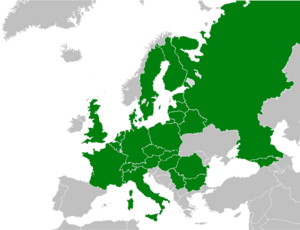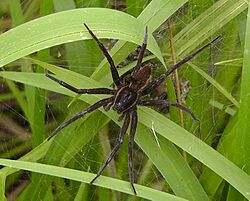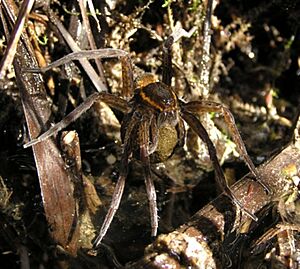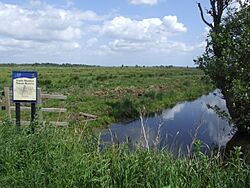Great raft spider facts for kids
Quick facts for kids Great raft spider |
|
|---|---|
 |
|
| An adult female great raft spider on the surface of a water pool | |
| Conservation status | |
| Scientific classification | |
 |
|
| Countries with a recorded population of D. plantarius | |
| Synonyms | |
|
Araneus plantarius |
The great raft spider or fen raft spider (Dolomedes plantarius) is a large spider found in Europe. It belongs to a group of spiders called Dolomedes. These spiders are special because they live partly in water. They hunt for their food right on the water's surface!
You can usually find great raft spiders in areas with clean, still, or slow-moving water. They like places like fens (wetlands) and wet grasslands.
Contents
About the Great Raft Spider
The great raft spider is quite big for a spider in Europe. Adult females can have bodies over 20 mm long. Their legs can stretch out to about 70 mm, which is almost the length of a credit card!
These spiders are usually black or brown. They have cool white or cream stripes along the sides of their bodies. They look a lot like another spider called the raft spider (Dolomedes fimbriatus). Because they look so similar, people sometimes mix them up.
How They Live: Habitat and Diet
Where Great Raft Spiders Live
Just like most Dolomedes spiders, the great raft spider loves water. It lives in low-lying fens and wet grasslands. It needs still or slow-moving water that is clean.
You can find them near the edges of ponds or ditches. Plants growing out of the water are very important for them. Spiders use these plants to sit on while hunting or warming up in the sun. They also use them to build their nurseries for baby spiders. These spiders like warm places, so they avoid areas where the water is always in the shade.
What Great Raft Spiders Eat
Great raft spiders are hunters. They wait on plants at the water's edge to catch their food. They mostly eat small water creatures like pond skaters and dragonfly larvae. They also eat smaller water spiders and even tiny fish.
Sometimes, they will eat insects that fall into the water. They have even been seen catching small sticklebacks (a type of fish) and tadpoles!
To hunt in the water, they have special sensory hairs called chaetae on their legs. These hairs help them feel tiny movements or vibrations on the water's surface. This tells them where their prey is. A spider will often sit with its back legs on a plant stem and its front legs touching the water. When it finds prey, it can run across the water's surface using surface tension. They can even hunt underwater by running down plant stems to catch food or hide from predators!
Life Cycle and Reproduction
Water is super important for the great raft spider's entire life. These spiders usually live for about two and a half years. Young spiders will hibernate (sleep through) the winter. They become adults in their last spring. In the UK, adult spiders usually try to breed twice between July and September.
The male spider uses his special sensory hairs to find a female. Their courtship happens on the water. The male slowly and carefully moves towards the female. He taps the water surface with his legs. When they are close, they do a slow bobbing dance. If the female accepts him, mating is very quick, lasting only a few seconds.
The female spider lays hundreds of eggs in a silk sac. This sac is about 10 mm wide. She carries it under her body for about three weeks. During this time, she dips the sac into the water now and then. This stops the eggs from drying out. She also looks for a good spot to build a nest among the plants growing out of the water. This nest is usually between 10 and 100 cm above the water.
Just before the eggs hatch, she builds a tent-like nursery web. She guards her young inside this web until they leave, usually five to nine days after hatching. If a female tries to have a second group of babies later in the summer, these groups are usually smaller and less likely to survive. Male spiders usually die soon after mating, often by late July. Females live until the end of the summer.
Where Great Raft Spiders Are Found

Great raft spiders live across Europe and Russia. You can find them in many countries, including Austria, Belgium, France, Germany, Hungary, Latvia, the Netherlands, Poland, Sweden, Switzerland, and the United Kingdom.
In the UK, the first great raft spider was found in 1956 at Redgrave and Lopham Fen. Later, two more groups were found. One was at the Pevensey Levels in East Sussex in 1988. Another was found near Swansea, South Wales, in 2003. It's hard to know how much their numbers have changed over time because there aren't many old records.
In July 2013, a wildlife fan found a spider that looked like a great raft spider in Norway. Experts later confirmed it was indeed a great raft spider. This was the first time this spider was officially seen in Norway!
Protecting the Great Raft Spider
The great raft spider is found in many places in Europe. However, it's hard to know exactly how many there are. This is because people don't always record them, and they are often confused with other spiders. Their numbers have gone down a lot, especially in western and central Europe. But in places like Scandinavia and the Baltic States, their populations seem to be doing well.
The main reason their numbers are dropping is because their homes (habitats) are being damaged or disappearing. The great raft spider is listed as a vulnerable species on the IUCN Red List. This means it's at risk of becoming endangered.
Protecting Them in the UK
The great raft spider is very rare in the UK. It has only been found at three main sites. Because it's so rare, it's listed as vulnerable. It used to be listed as endangered! It is protected by law in England, Wales, and Scotland.
One of the main threats to these spiders in the UK is when too much water is taken from their habitats. Other problems include bad ditch management, dirty water, and the loss of their wetland homes.
In 2010, a special project helped introduce great raft spiders to a new place in the UK. About 3,000 baby spiders were raised by scientists. Then, 1,600 of them were released into suitable ditches at the Castle Marshes nature reserve. This reserve is part of the Suffolk Broads.
The baby spiders came from adults from two different UK populations. This was done to make the new group of spiders more genetically diverse. This helps them be stronger and more likely to survive. Each baby spider was raised by hand in its own test tube and fed tiny fruit flies. If this new group of spiders does well, it will be one of only four great raft spider populations in the UK! Some spiders were also added to Redgrave and Lopham Fen to help the small group already living there.




